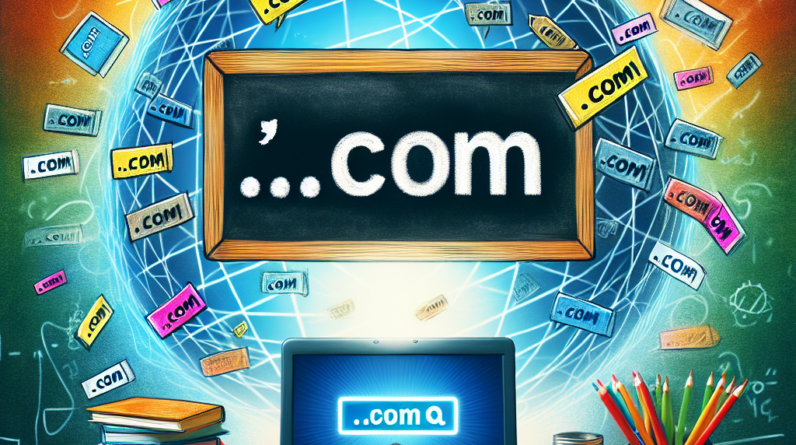
So, you’ve successfully established your multinational corporation with a “.com” domain. Congratulations! But have you thought about the challenges that come with maintaining it? In this article, we will explore the key considerations that every multinational corporation should keep in mind when it comes to managing their online presence. From legal and cultural factors to technical and security aspects, we’ve got you covered. So, grab a cup of coffee and let’s dive into the world of maintaining a “.com” domain.

1. Legal considerations
1.1 Compliance with local laws
When maintaining a “.com” domain as a multinational corporation, it is crucial to ensure compliance with local laws in all the countries where you operate. Each country may have different regulations regarding data privacy, consumer protection, and online business practices. It is important to familiarize yourself with these laws and ensure that your website and online activities align with the legal requirements of each jurisdiction.
1.2 Intellectual property rights
Multinational corporations often need to be vigilant about protecting their intellectual property rights when maintaining a “.com” domain. This involves registering trademarks, copyrights, and patents in relevant jurisdictions and monitoring for any potential infringements. Unauthorized use of your company’s name, logo, or products can harm your brand reputation and lead to legal disputes. It is important to have clear policies in place to protect your intellectual property and take appropriate legal action against any infringements.
1.3 Trademark protection
Trademark protection is another crucial aspect to consider when maintaining a “.com” domain. Trademarks provide exclusive rights to use certain names, logos, or slogans in connection with specific goods or services. It is essential to register your trademarks in the relevant countries to prevent unauthorized use by competitors or third parties. Regular monitoring for trademark infringements and taking appropriate legal action when necessary can help safeguard your brand and avoid any confusion or damage to your reputation.
1.4 Domain name disputes
Domain name disputes can arise when multiple parties claim rights to a particular domain name. As a multinational corporation, it is important to be proactive in protecting your domain names. This involves registering domain names relevant to your brand in different countries and monitoring for any potential infringements or unauthorized use. In case of disputes, it may be necessary to engage in legal proceedings or utilize alternative dispute resolution mechanisms, such as domain name arbitration, to protect your rights and maintain control over your online presence.
2. Localization and language
2.1 Translation and localization
Localization involves adapting your website content, products, and services to cater to the local language and culture of your target markets. When maintaining a “.com” domain, it is essential to invest in professional translation services to ensure accurate and culturally appropriate content for each country. This includes translating website text, product descriptions, marketing materials, and legal documents. Localization also extends to adapting images, symbols, and colors to resonate with local audiences.
2.2 Cultural sensitivity
Cultural sensitivity is crucial when maintaining a “.com” domain as a multinational corporation. Different countries have distinct cultural norms, values, and sensitivities that need to be considered in your website and communication strategies. Understanding local customs, traditions, and taboos is vital to avoid any unintentional offense or misunderstandings. It is important to conduct thorough research on each target market’s cultural nuances and tailor your content and messaging accordingly.
2.3 User experience
Maintaining a positive user experience is paramount when managing a “.com” domain. The website should be designed with the target audience in mind, ensuring ease of navigation, clear communication, and intuitive functionality. Pay attention to factors such as page loading speed, mobile responsiveness, and easy checkout processes. Conduct user testing and gather feedback to continuously improve the user experience and meet the specific preferences and expectations of your global customers.
2.4 Content management
Effective content management is essential for maintaining a compelling online presence across different markets. This involves creating and curating relevant and engaging content for each target market. Regularly update your website with fresh content, industry news, and localized blogs or articles to attract and retain customers. It is also important to implement a robust content management system that facilitates efficient workflows, supports multilingual content, and enables easy content updates across different regions.
3. Market expansion and targeting
3.1 Target audience analysis
Before expanding into new markets, conducting a thorough analysis of your target audience is crucial. Understand their demographics, preferences, behaviors, and purchase patterns to tailor your marketing strategies effectively. This analysis will help you identify the most viable markets to target and create localized marketing campaigns that resonate with your potential customers in each region.
3.2 Country-specific regulations
Each country may have specific regulations and restrictions governing advertising, marketing, and business practices. It is important to research and adhere to these regulations to ensure compliance and avoid any legal issues. Some countries may require pre-approval for certain advertising materials or restrict the use of specific marketing tactics. By understanding and complying with country-specific regulations, you can build trust with local authorities and customers alike.
3.3 Advertising and marketing strategies
When maintaining a “.com” domain, your advertising and marketing strategies should be adapted to suit each target market. This involves tailoring your messaging, visuals, and channels to resonate with the cultural and linguistic preferences of your audience. Utilize local influencers, social media platforms, and advertising channels that are popular in each country. Consider the impact of cultural events, holidays, and seasonal trends on your marketing campaigns to effectively engage your target audience.
3.4 Competitor analysis
Staying competitive in international markets requires a thorough understanding of your competitors. Conduct competitor analysis to identify their strengths, weaknesses, positioning, and marketing strategies. This analysis will help you differentiate your brand and products, tailor your value proposition, and identify areas of opportunity. By staying informed about your competitors’ activities, you can make informed decisions and develop effective strategies to gain a competitive edge in each target market.
4. Technical considerations
4.1 Website hosting and server locations
When maintaining a “.com” domain as a multinational corporation, it is important to consider your website hosting and server locations. Choose reliable hosting providers that offer server locations in various countries to ensure optimal website performance and accessibility for your global audience. Hosting your website on servers located closer to your target markets can help reduce latency and improve loading speed, enhancing the overall user experience.
4.2 Website performance and speed
Website performance and speed are critical factors in maintaining a positive user experience and ensuring customer satisfaction. Optimize your website’s performance by implementing caching techniques, compressing images, and minimizing code. Regularly monitor your website’s loading speed and conduct performance tests to identify any bottlenecks or areas for improvement. A fast and responsive website will not only enhance user experience but also contribute to better search engine rankings.
4.3 Security measures
Ensuring the security of your “.com” domain is essential for protecting your business and customer data. Implement robust security measures, such as SSL certificates, firewalls, and malware detection software, to safeguard your website from potential threats. Regularly update your website’s software and plugins to patch any known vulnerabilities. Additionally, educate your employees about cybersecurity best practices to minimize the risk of data breaches and unauthorized access.
4.4 Domain management and administration
Efficient domain management and administration are vital for maintaining a “.com” domain. Keep track of your domain names, renewal dates, and contact information to avoid any lapses in registration or unauthorized transfers. Employ domain registration services that offer comprehensive management tools and automate renewal processes. Regularly review and update domain name registrations to align with your business objectives and target markets.

5. SEO and search engine visibility
5.1 Keyword localization
Adapting your SEO strategy to each target market is crucial for maintaining a strong online presence. Conduct keyword research to identify relevant and high-traffic keywords in local languages. Incorporate these keywords into your website content, meta tags, headings, and URLs to improve search engine visibility in each country. By optimizing your website for local search terms, you can attract more organic traffic and increase your chances of ranking higher on search engine results pages.
5.2 Local search engine optimization
Local SEO involves optimizing your website and online profiles for specific locations. Claim and optimize your Google My Business profile for each target market to improve local search visibility. Ensure consistent and accurate business information across all online directories and review platforms. Engage with local customers by responding to reviews and encouraging them to leave feedback. Localized SEO strategies will help your multinational corporation appear prominently in local search results and attract geographically targeted customers.
5.3 Backlinks and online reputation
Building a strong backlink profile is crucial for improving your search engine rankings and online reputation. Actively seek opportunities to acquire high-quality backlinks from reputable websites in each target market. Collaborate with local influencers or industry experts to create guest blog posts or conduct interviews. Encourage satisfied customers to leave positive reviews and testimonials on relevant platforms. By earning backlinks and cultivating a positive online reputation, you can enhance your credibility and visibility in each target market.
5.4 Country-specific search engines
In addition to popular search engines like Google and Bing, some countries have their own local search engines that dominate the market. For example, Baidu in China or Yandex in Russia. When maintaining a “.com” domain, it is important to consider optimizing your website for these country-specific search engines. Research their algorithms, ranking factors, and features to tailor your SEO strategies. Engaging with local SEO experts or agencies can provide valuable insights and guidance for effectively targeting these specific search engines.
6. Brand management and consistency
6.1 Branding guidelines
Maintaining consistent branding across different markets is essential for building brand recognition and trust. Develop comprehensive branding guidelines that cover visual elements, tone of voice, messaging, and customer experience. These guidelines should be shared with all stakeholders, both internal and external, to ensure consistent implementation of your brand identity. Monitor and regularly audit your brand assets across different channels to maintain a consistent and cohesive brand image.
6.2 Visual identity
Visual identity plays a crucial role in maintaining brand recognition and consistency. Adapt your visual elements, such as logo, color palette, and typography, to align with the cultural preferences and aesthetics of each target market. This may involve creating localized versions of your logo or using different color combinations. Ensure that your visual identity maintains a cohesive look and feel across all marketing materials, both online and offline.
6.3 Brand messaging
Adapting your brand messaging to resonate with local audiences is vital for successful international branding. Translate and localize your brand messaging to ensure that it effectively communicates your value proposition and resonates with the cultural nuances of each target market. Tailor your marketing campaigns and content to address local needs, aspirations, and pain points. By speaking the language of your customers and demonstrating an understanding of their unique challenges, you can build trust and loyalty.
6.4 Customer trust and loyalty
Maintaining customer trust and loyalty is crucial for the sustained success of a multinational corporation. Prioritize transparency, honesty, and ethical business practices in all your interactions with customers. Ensure clear communication about data privacy, security measures, and customer support processes. Establish a robust customer feedback system and promptly address any concerns or complaints. By prioritizing customer satisfaction and loyalty, you can build strong, long-term relationships with your global customer base.
7. Data privacy and compliance
7.1 Data protection laws
Data privacy laws vary from country to country, and it is important to understand and comply with the regulations in each jurisdiction where you operate. Multinational corporations need to have robust data protection policies in place to safeguard personal information. This includes implementing measures such as secure data storage, encryption, and strict access controls. Regularly review and update your data protection practices to align with evolving privacy regulations to maintain your customers’ trust.
7.2 GDPR compliance
For businesses operating in the European Union (EU) or dealing with EU citizens’ data, compliance with the General Data Protection Regulation (GDPR) is essential. GDPR provides comprehensive guidelines for the collection, processing, and storage of personal data, and failure to comply can result in substantial fines. Establish procedures to ensure GDPR compliance, including obtaining explicit consent from users, providing clear privacy notices, and responding promptly to data subject requests. Regularly train your employees on GDPR requirements to minimize the risk of non-compliance.
7.3 Consent management
Consent management is crucial when maintaining a “.com” domain. Ensure that you have mechanisms in place to obtain and manage user consent for collecting and processing their personal data. Provide clear and easily accessible opt-in and opt-out options for users to control their data preferences. Regularly review your consent management processes and continuously educate your users about their rights and data protection measures to foster trust and transparency.
7.4 User data localization
Data localization refers to the requirement of storing and processing user data within specific geographical boundaries. Some countries have regulations that mandate user data localization to protect national security or privacy concerns. When maintaining a “.com” domain, it is important to understand the data localization requirements in each target market and ensure compliance. This may involve partnering with local data centers or cloud service providers with server locations in the relevant jurisdictions.
8. Customer support and communication
8.1 Language support
Providing language support is essential for effectively serving your global customers. Maintain a website interface that allows users to select their preferred language and easily switch between language options. Provide multilingual customer support through various channels, such as phone, email, and live chat, to address customer queries and issues in their native language. Investing in professional translation and interpretation services can significantly enhance the customer experience and build trust.
8.2 Local customer service teams
When maintaining a “.com” domain, consider establishing local customer service teams in each target market. Local teams can better understand the cultural nuances, expectations, and local business practices, enabling them to provide more personalized support. Hiring native speakers or employees familiar with the local market can facilitate effective communication and enhance customer satisfaction. Local customer service teams can handle specific inquiries, resolve issues, and ensure prompt and efficient support.
8.3 Communication channels
Offering diverse communication channels is vital for maintaining an effective customer support system. Provide options such as email, live chat, phone support, and social media platforms to cater to different customer preferences. Monitor these channels regularly and respond promptly to customer inquiries or concerns. Implement a comprehensive customer relationship management (CRM) system to centralize customer interactions, track support tickets, and ensure efficient communication across different markets.
8.4 Complaint management
Handling customer complaints effectively is essential for maintaining customer satisfaction and loyalty. Implement a robust complaint management system that includes clear processes for logging, tracking, and resolving customer complaints. Ensure that customer feedback and complaints are taken seriously and promptly addressed. Regularly review and analyze customer complaints to identify any systemic issues and implement improvements to prevent similar problems in the future. By demonstrating responsiveness and accountability, you can turn dissatisfied customers into loyal brand advocates.
9. Budget and resource allocation
9.1 Domain registration and renewal
Budgeting for domain registration and renewal expenses is crucial for maintaining a “.com” domain. Consider the costs associated with registering and renewing domain names in different countries, as well as any additional fees for privacy protection or domain brokers. Allocate sufficient resources to ensure timely renewal and minimize the risk of losing control over your domain names. Regularly review your domain portfolio to optimize expenditure and align with your global business objectives.
9.2 Translation and localization costs
Translation and localization costs should be factored into your budget when maintaining a “.com” domain. Professional translation services can be a significant investment, especially for multiple target markets and ongoing content updates. Consider partnering with localization agencies or freelance translators with expertise in your industry and target languages. Prioritize high-quality translations to ensure accurate and culturally appropriate content for your global audience.
9.3 Marketing and advertising expenses
Marketing and advertising expenses are crucial for promoting your “.com” domain globally. Allocating budget for targeted advertising campaigns, content creation, social media marketing, and influencer collaborations is important for expanding your brand’s reach. Take into account the variations in advertising costs and practices in different countries. Continuously monitor the performance of your marketing initiatives and adjust your budget allocation to maximize return on investment and drive business growth.
9.4 IT infrastructure and support
Investing in a robust IT infrastructure and support system is necessary when managing a “.com” domain. Allocate resources for reliable web hosting, servers, and content delivery networks to ensure optimal website performance and availability. Consider outsourcing IT support or partnering with managed service providers to handle technical issues, security updates, and server maintenance. Regularly review your IT infrastructure to ensure scalability, security, and efficiency in supporting your global online operations.
10. Social and political considerations
10.1 Cultural sensitivities
Cultural sensitivities can significantly impact multinational corporations when maintaining a “.com” domain. Be aware of cultural norms, traditions, and values in each target market to avoid any unintentional offense or cultural misunderstandings. Adapt your marketing messages, visuals, and campaigns to align with local customs and preferences. Engage in ongoing cultural competency training for your employees to ensure respectful and culturally sensitive interactions with customers and stakeholders.
10.2 Political stability
Political stability is a crucial consideration for multinational corporations when maintaining a “.com” domain. Monitor the political climate and stability in each target market to assess any potential risks to your business operations. Unstable political situations can lead to regulatory changes, disruptions in trade, and potential security threats. Develop contingency plans and risk management strategies to mitigate the impact of political instability on your international business endeavors.
10.3 Government regulations
Government regulations can significantly impact multinational corporations operating a “.com” domain. Stay informed about the regulatory landscape of each target market to ensure compliance with local laws and regulations. Regulatory requirements may include licensing, taxation, labor laws, and industry-specific regulations. Engage with local legal counsel or consultants to navigate and understand the regulatory environment. By remaining abreast of changes and proactively adapting, you can minimize compliance risks and maintain a strong legal standing.
10.4 Ethical considerations
Maintaining a high standard of ethics is crucial for multinational corporations when managing a “.com” domain. Consider ethical considerations such as fair labor practices, environmental sustainability, and responsible sourcing. Align your business practices with internationally recognized ethical guidelines, industry standards, and corporate social responsibility principles. Transparently communicate your ethical commitments to build trust and credibility with your global customer base. Regularly review and audit your ethical practices to ensure continuous improvement and compliance.







